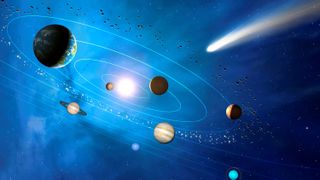Planets of Our Solar System in Order: A Complete Guide

The planets of our solar system, in order, are Mercury, Venus, Earth, Mars, Jupiter, Saturn, Uranus, and Neptune.
The Order Of Planets In Our Solar System
The order of planets in our solar system, starting from the closest to the Sun and working outward, is Mercury, Venus, Earth, Mars, Jupiter, Saturn, Uranus, and Neptune. Mercury is the closest planet to the Sun, while Neptune is the farthest.
| Mercury | The closest planet to the Sun |
| Venus | The second planet from the Sun |
| Earth | Our home planet |
| Mars | The fourth planet from the Sun |
| Jupiter | The largest planet in the Solar System |
| Saturn | The planet known for its beautiful rings |
| Uranus | The seventh planet from the Sun |
| Neptune | The farthest planet from the Sun |

Credit: www.space.com
Why Pluto Is Not Considered A Planet
Pluto is not considered a planet because it is now classified as a dwarf planet. The order of the planets in our solar system, in order of distance from the Sun, is as follows: Mercury, Venus, Earth, Mars, Jupiter, Saturn, Uranus, and Neptune.
| Planets of Our Solar System in Order: |
| Mercury, Venus, Earth, Mars, Jupiter, Saturn, Uranus, Neptune. |
| Why Pluto is Not Considered a Planet: |
| The reclassification of Pluto as a dwarf planet has caused a reevaluation of the definition of a planet. Previously, Pluto was considered the farthest planet from the Sun. However, some scientists believe that Pluto does not meet the criteria to be classified as a planet due to its small size and its orbit crossing that of Neptune. The debate surrounding Pluto’s classification continues, and it remains a point of interest and discussion among astronomers and space enthusiasts. |
The Importance Of The Asteroid Belt
The asteroid belt holds great importance in our solar system. It lies between Mars and Jupiter and is composed of numerous rocky objects. These asteroids play a crucial role in understanding the formation and evolution of our planets, offering valuable insights into the history of our solar system.
| The Importance of the Asteroid Belt |
| Location and composition of the asteroid belt |
|
The asteroid belt is a vast region located between the orbits of Mars and Jupiter. It is primarily composed of rocky and metallic objects, ranging in size from small boulders to large asteroids. These objects are remnants from the early formation of the solar system, when planets were still in the process of forming.
The asteroid belt plays a crucial role in our solar system. Firstly, it acts as a source of meteorites that occasionally enter the Earth’s atmosphere, allowing scientists to study the composition and nature of these extraterrestrial materials. Additionally, the gravitational influence of the asteroid belt helps to stabilize the orbits of the inner planets, preventing them from colliding with each other or being perturbed by the gravitational pull of outer planets. The asteroid belt is also of great scientific interest, as it contains valuable information about the early stages of planetary formation. By studying the composition and properties of asteroids in the belt, scientists can gain insights into the processes that led to the formation of the planets we see today. Overall, the asteroid belt is a fascinating and important component of our solar system, contributing to both scientific understanding and planetary stability. |
Frequently Asked Questions Of Planets Of Our Solar System In Order
What Is The Order Of The 9 Planets?
The order of the 9 planets in our solar system, starting from closest to the sun, is Mercury, Venus, Earth, Mars, Jupiter, Saturn, Uranus, and Neptune.
Are There 8 Or 9 Planets?
There are eight planets in our solar system. They are Mercury, Venus, Earth, Mars, Jupiter, Saturn, Uranus, and Neptune.
What Are The 8 Planets In Chronological Order?
The eight planets in order from closest to the sun to farthest are: Mercury, Venus, Earth, Mars, Jupiter, Saturn, Uranus, and Neptune.
What Is The Rhyme For Remembering The Planets?
The order of the planets in our solar system, starting from the nearest to the Sun, is Mercury, Venus, Earth, Mars, Jupiter, Saturn, Uranus, and Neptune.
Conclusion
To recap, the planets in our Solar System are Mercury, Venus, Earth, Mars, Jupiter, Saturn, Uranus, and Neptune. Starting from the closest to the Sun and moving outward, each planet has its unique characteristics and significance. While Pluto was once considered the farthest planet, it is now classified as a dwarf planet.
By remembering the simple mnemonic “My Very Easy Method Just Speeds Up Nothing,” you can easily recall the order of the planets. Understanding the arrangement of these celestial bodies not only expands our knowledge but also showcases the vastness and beauty of our Solar System.










